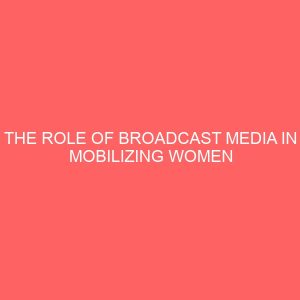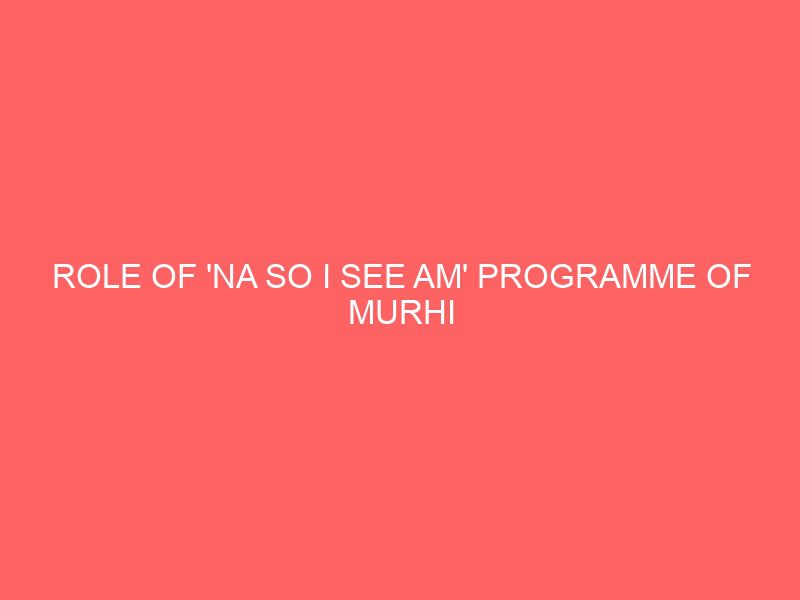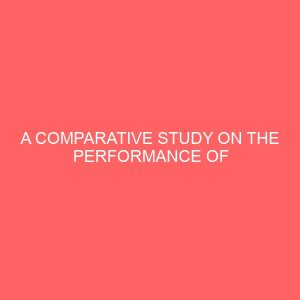Description
CHAPTER ONE
1.1 INTRODUCTION
Background of the Study
Communication and culture are intertwined. This lies in the fact that they are relevant to the proper functioning and relationships of the different groups within the society. In this sense, the various ethnic groups can be brought together in common understanding of their differences, uniqueness and similarities particularly through broadcasting. This art of sharing and exchanging of information, ideas and meanings which communication is, is one unique attribute of humans especially when considering the use of verbal and nonverbal gesture communication cues as means of achieving this exchange. Agba 2002, p. 247 states that communication is also an ideological or cultural creation. Meanings are understood within the context of a peoples taste, values, norms and philosophy generally. The MacBrides commission of 1981 defines communication thus:Communication maintains and animates life. It is also the motor and expression of social activities and civilization, it leads people from instinct to inspiration, through variegated process and system of enquiry to command and control, it creates a common pool of ideas, strengthens the feelings of togetherness through exchange of messages, and translates thought into action, reflecting every motion and need from the humblest task of human survival to supreme manifestation of creativity or destruction.
Communication is very paramount to societal survival. No society exists without an adequate communication system to hold it together. It is an interaction process through which persons or groups relate to each other and share information, experiences and culture. The whole essence of communication however is to meet the information needs of the people hence; communication is not an end itself. It is an elemental social process on which all other social process depends as a social technique. Without communication, there are no interstimulations among people; people will not have common meanings of things and there will be no action that could provide information.
Due to the expansion of societal needs, the usage of communication at the interpersonal level was further expanded to accommodate mass communication, hence today there is mass communication as the dissemination of messages through the mass media of communication to a large diverse and heterogeneous audiences. Defleur and Dennis 1991 see mass communication as a process in which professional communicators use the mass media to disseminate messages widely, rapidly and continuously to arouse intended meanings in large and diverse audiences in attempts to influence them in a variety of way. Okunna 1999,p.7 says that it cannot take place in a face to face situation because its audience is usually scattered. And of the various tools of mass communication is the electronic or broadcast media which concerns itself with the dissemination of electronic means of messages via the airwaves.
The whole essence of broadcasting therefore is to create a forum for the immediate and continued exchange of commonalities and meanings in National communication needs. This in turn is expected to bring about integration especially in multicultural society like ours in Nigeria. The broadcast media of which radio is an intrinsic part was designed to be a companion, sharing useful information that could help knit the fabric of society closer as well as promote sociocultural, economic cum political gains for the people. Due to this important factor, the broadcast media are seen as veritable tools required in the mobilization and integration into the mainstream of governance. Where there exist programmes using both audio and visual signals while radio is restricted to the dissemination of audio messages only designed to help men satisfy his various needs and also to promote togetherness among people through its lofty and well packaged programmes.
Broadcasting has continued to serve as a tool for national development as it helps in creating awareness of the various cultural entities in Nigeria. One of the areas which broadcasting has been successfully used as a National integration tool is the area of cultural diffusion. To promote culture implies telling the Nigerian people about the richness of the various cultures that exist in our society and environment in terms of cultural heritage.
Brief History Of The Yoruba People
The Yoruba people occupy the south western part of Nigeria. They account for about 20 of the population of the country. They are a religious group of people who are mainly Christians, Muslims or of traditional beliefs. The Yoruba people have different stories about their origin but they all relate to the same ancestor Oduduwa. One of the stories has it that Oduduwa the father of the Yorubas was sent by God from heaven accompanied by his lieutenants and landed at the Ile Ife, where he proceeded with his mission. The chain with which he landed onto earth is still said to exist in the shrine though it is said to be hidden from profane eyes.
The Yoruba people occupy the states Ondo, Oyo, Osun, Lagos, Ogun and Ekiti and some parts of Kwara and Edo states respectively. Some of the prominent works of the Yoruba people are in the field of art, where the works that come out of them compete favourably with that of ancient Greece and Rome. Regardless of their origin, the Yoruba people of Nigeria have proved themselves to be a people of a dynamic culture and tradition.
Brief History Of The Egun People.
Badagry was established in 1425 AD and was established by a farmer whose farm stretched across the lagoon called Agbede. Agbede in Egun language implies Agbedegreme but this was later changed to Agbadarigi by the Yoruba alien of the south west Nigeria and later to Badagry by the European slave. The main language of the people is Egun language. Slave trade occurred in Badagry in the early 16th century to the late 18th century for about 300 years by the European slave dealers and this has made the town a tourists attraction where tourists from all over the world visit every day.
Brief History Of Murhi International Television
MITV is one of the first eleven private Television stations in Nigeria licensed by the NBC and the federal government as far back as 1993/94 during the Babangida regime when the broadcast industry was deregulated.
MITV began commercial transmission on the 12th of August 1996 and since then have been on air consistently.
MITV inspite of the encumbrances of public service bureaucracy has been able to sustain its frontline position especially in terms of crystal clear signals as well as content that conforms to international standards in the contemporary television industry.
1.2 Statement Of Research Problem
Despite the fact that the Yoruba and Egun ethnic groups in Lagos state live together they still have some cultural differences between them which sometimes seem to bring some intercrisis between them. Therefore this study seeks to answer the question How has Na So I See Am programme of MITV Lagos state been able to integrate the two ethnic groups.
In this study, the researcher intends to discuss the role of Na so I see Am programme of MITV Lagos state in the integration of the two ethnic groups.
1.3 Objectives Of The Study
The objectives of this study were:
a. To find out the popularity of the programme Na So I See Am on MITV amongst the Yoruba and Egun ethnic groups of Lagos State.
b. To find out how the television programme Na So I See Am on MITV has helped in promoting the cultures of the Yoruba and Egun people of Lagos State.
c. To find out how the Television programme Na So I See Am has helped in integrating the cultures of the Yoruba and Egun people of Lagos State.
1.4 Research Questions
This research will attempt answering the following questions.
1. To what extent is the television programme Na So I See Am popular amongst the Yoruba and Egun ethnic groups in Lagos state
2. In what ways have the programme Na So I See Am been able to promote the cultures of the Yoruba and Egun people of Lagos state
3. To what extent has the programme Na So I See Am helped in integrating the Yoruba and Egun ethnic groups of Lagos State.
1.5 Scope And Limitation Of The Study
Scope of the study according to Nworgu 1991:46 refers to all those aspects of the study that the researcher eliminates off due to certain pertinent reasons. It has to do with the content area coverage of the study and so, the study of other ethnic groups may not be relevant to this study. The major limitation of the group is the samples that were only from Badagry and Lagos State which were chosen as the area in carrying out this research. This finding is based on the results gathered from Lagos State and Badagry on the integration of Yoruba and Egun ethnic groups.
1.6 Significance Of The Study
This study is important in that, the broadcast media should be seen to be responsible first to the public. Its effectiveness in executing these responsibilities will determine its credibility rating before the people. A high rate will help preserve its financial autonomy in the sense that they wont be indebted to anyone or the government both financially and materially and thus, prevent it from becoming dependent on special interest and influences that will harm its existence. This study is important because it will find out how the activities of the television programme Na So I See Am have helped in cultural development, sustenance of culture, promotion of culture and cultural integration. Similar studies have been done on this subject in the past. Also, many people in future will undertake research studies such as this or on other related subjects. Thus, this study will be a preliminary work and equally, a reference point for those that will be carried out in future.
1.7 Definition Of Terms
1. Broadcast: A broadcast is a programme, performance or speech on the radio or on television.
2. Culture: Culture consists of activities such as the arts and philosophy which are considered to be important for the development of civilization and of peoples minds.
3. Integration: Becoming part of a group being accepted into a group.
4. Society: A society is the people who live in a country or region, their organizations and their way of life.
5. Communications: This means sharing or exchanging information with people, for example by speaking, writing or using equipment.








Reviews
There are no reviews yet.